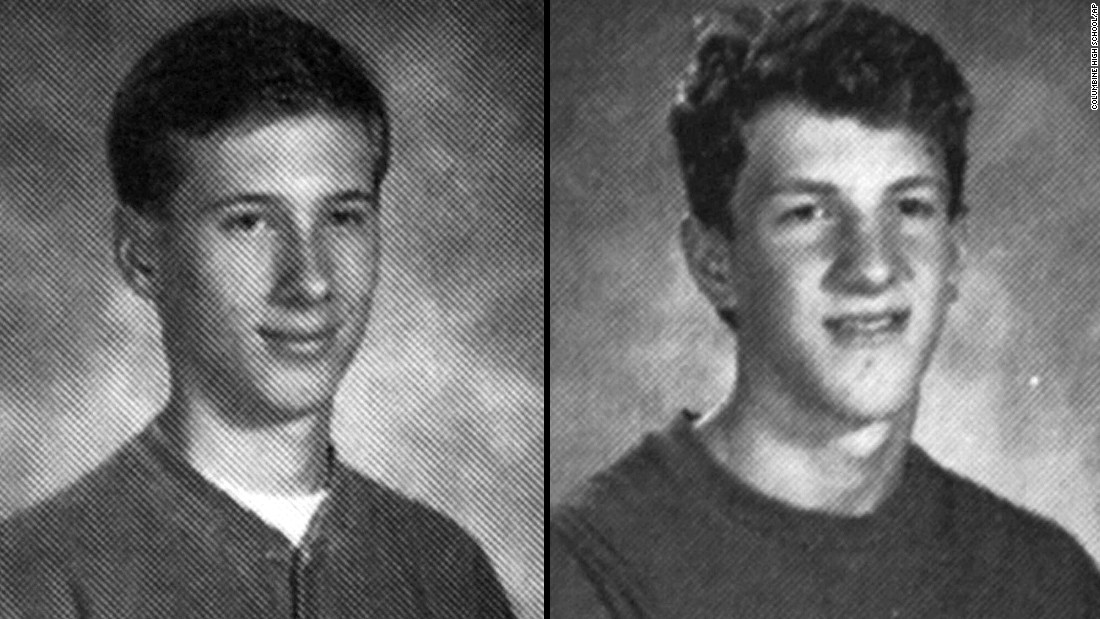Hey there, friend. If you're diving into the Columbine shooting, you're stepping into one of the most harrowing chapters in modern history. The names Eric Harris and Dylan Klebold have become synonymous with a tragedy that reshaped how we view school safety and mental health in America. This story isn’t just about two teenagers; it’s about understanding the why, the how, and the aftermath that still echoes today. Let’s talk about it, shall we?
The Columbine High School shooting isn’t just a historical event; it’s a wake-up call that forced society to confront uncomfortable truths. On April 20, 1999, Eric Harris and Dylan Klebold walked into their high school in Colorado and turned what should have been an ordinary day into a national nightmare. This event changed everything—how schools operate, how we discuss mental health, and even how we perceive teenagers.
Now, before we dive deep, let’s set the stage. This isn’t just a recount of events; it’s an exploration of the lives behind the headlines, the decisions that led to that fateful day, and the lessons we can still learn today. Ready? Let’s go.
Read also:Free Inmate Locator Texas Your Ultimate Guide To Finding Loved Ones
Table of Contents
- Biography of Eric and Dylan
- Timeline of the Columbine Shooting
- What Motivated Eric and Dylan?
- Mental Health and the Warning Signs
- The Impact on Columbine and Beyond
- Aftermath and Changes in Policy
- Lessons Learned from the Tragedy
- The Columbine Memorial
- Common Misconceptions About the Shooting
- Conclusion: Reflecting on Columbine
Biography of Eric Harris and Dylan Klebold
Eric Harris and Dylan Klebold weren’t just names in a news report; they were real people with complex lives. To truly understand what happened at Columbine, we need to know who these two were.
Basic Facts
Let’s start with the basics. Below is a quick rundown of their personal details:
| Name | Age | Birthdate | Place of Birth |
|---|---|---|---|
| Eric Harris | 18 | April 9, 1981 | Kansas |
| Dylan Klebold | 17 | September 11, 1981 | Colorado |
Both teens were born in the late '80s and grew up in relatively normal suburban environments. But beneath the surface, there were signs of trouble brewing.
Timeline of the Columbine Shooting
Let’s break down what happened on that tragic day. It’s not easy to recount, but it’s crucial to understanding the full scope of the tragedy.
- April 20, 1999: Eric and Dylan arrived at Columbine High School armed with guns and bombs.
- 11:19 AM: The first shots were fired in the school cafeteria.
- 12:08 PM: The shooters turned their weapons on themselves, ending the massacre.
In less than an hour, 12 students and one teacher were killed, and 21 others were injured. It was chaos, heartbreak, and a moment that changed America forever.
What Motivated Eric and Dylan?
People often ask, “Why did they do it?” The truth is, there’s no simple answer. Eric and Dylan left behind journals and videos that provide some clues, but the full picture remains murky.
Read also:Pasco County Fl Official Records Your Ultimate Guide
Eric Harris: The Mastermind
Eric was often described as the driving force behind the plan. He had a deep fascination with violence and a desire for revenge against what he perceived as a world that wronged him. His journals revealed a chilling sense of superiority and a belief that he was destined for greatness, even if it meant destruction.
Dylan Klebold: The Troubled Soul
Dylan, on the other hand, seemed to be driven by deep depression and a desire to escape the pain of his existence. His writings suggest someone who felt isolated and misunderstood, seeking an end to his suffering. Together, they created a plan that would leave a scar on the nation.
Mental Health and the Warning Signs
Mental health played a significant role in the Columbine tragedy. Both Eric and Dylan exhibited signs of psychological distress, but these were often overlooked or misunderstood.
- Eric’s Psychopathy: Eric displayed traits of psychopathy, including a lack of empathy and a manipulative nature.
- Dylan’s Depression: Dylan struggled with severe depression and feelings of inadequacy.
Experts agree that early intervention could have made a difference. But the stigma surrounding mental health, especially in the late '90s, made it harder for people to seek help or recognize the signs.
The Impact on Columbine and Beyond
The Columbine shooting didn’t just affect those directly involved; it had a ripple effect across the nation. Schools tightened security measures, mental health resources became a priority, and the conversation around gun control intensified.
For the families of the victims, the impact was immeasurable. Their lives were forever changed, and the pain of loss still lingers. But from that pain came a movement—a push for change that continues to this day.
Aftermath and Changes in Policy
In the wake of Columbine, several changes were implemented to prevent similar tragedies:
- Increased School Security: Metal detectors, security cameras, and resource officers became common in schools nationwide.
- Mental Health Support: More funding was allocated to mental health services for students.
- Gun Control Legislation: Though controversial, debates around gun control gained momentum.
These changes reflect a society trying to learn from its mistakes, but the debate over how to prevent school shootings continues to this day.
Lessons Learned from the Tragedy
What can we take away from Columbine? For one, the importance of mental health cannot be overstated. Recognizing the warning signs and providing support can make all the difference.
Additionally, fostering a culture of inclusion and empathy in schools can help prevent feelings of isolation and alienation. Columbine taught us that every student matters and that even the quietest voices deserve to be heard.
The Columbine Memorial
In memory of the victims, a memorial was erected near the site of the tragedy. It serves as a place of reflection and remembrance, honoring those who lost their lives that day.
The memorial isn’t just a tribute; it’s a reminder of the resilience of the human spirit. It shows that even in the face of unimaginable tragedy, communities can come together and find hope.
Common Misconceptions About the Shooting
Over the years, several myths have emerged about the Columbine shooting. Let’s clear some of them up:
- It Was About Bullying: While bullying was a factor for Dylan, it wasn’t the sole motivation for the attack.
- They Were Goth: Eric and Dylan’s fashion choices have been misinterpreted as a sign of their intentions, but their interests were far more complex.
- They Were Copycats: The idea that they were inspired by other shootings is unfounded; their plan was uniquely theirs.
Understanding the truth behind these misconceptions is key to preventing similar events in the future.
Conclusion: Reflecting on Columbine
As we reflect on the Columbine shooting, it’s important to remember that this wasn’t just a story of violence; it was a story of humanity. Eric and Dylan were flawed, troubled individuals whose actions had devastating consequences. But their story also highlights the importance of compassion, understanding, and action.
We invite you to share your thoughts in the comments below. What lessons do you think we can still learn from Columbine? And how can we work together to ensure that such tragedies never happen again? Let’s keep the conversation going.


